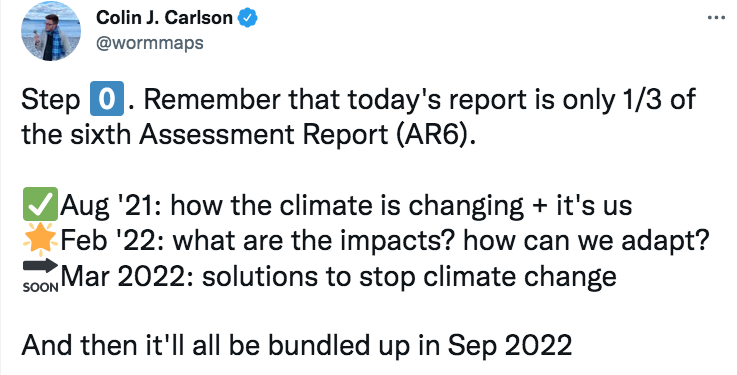
March 4, 2022, by Brigitte Nerlich
The IPCC report: Impacts, adaptation and vulnerabilities
When I think about the latest IPCC report, which came out on 28 February, these sentences come to my (German) mind:
Eintritt streng verboten!
Eintritt strengstens verboten!!
Eintritt allerstrengstens verboten!!!
(Entry strictly forbidden. Entry very strictly forbidden. Entry extremely strictly forbidden.)
These words are written on warning signs that adorn three doors in the classic children’s story Räuber Hotzenplotz by Otfried Preußler (1962) (link through to enjoy the illustrations by Franz Josef Tripp). In the book, Kasperl walks through these three forbidden doors and rescues a princess.
Unfortunately, there is no such happy ending with climate change. Every IPCC report has warned of the dangers of continued fossil fuel use and the increase in greenhouse gas emissions, using ever bigger warning signs. Nothing much has happened as a result. Rescuing princesses, or anybody else for that matter, becomes an ever more distant prospect.
IPCC report
So, let’s look at this newest IPCC report, which, of course, is only part and parcel of the 6th IPCC report – nicely summarised by Colin Carlson:
Let’s start with the final two sentences of the report: “The scientific evidence is unequivocal: climate change is a threat to human well-being and the health of the planet. Any further delay in concerted global action will miss a brief and rapidly closing window to secure a liveable future.”
Ok, so here we talk about windows not doors, but the message is absolutely clear. You can’t get a clearer statement. Climate change communication cannot improve on that. Basically:
It’s bad!
It’s very bad!!
It’s extremely bad!!!
Maladaptation and cooperation
The science is clear – we don’t really need to waste communication on that anymore, if at all possible. Climate change communication now has to adapt to a new world. Science is now needed to find the best ways to cope with local impacts and design appropriate adaptation measures, and communication needs to be involved here at every step. In fact, scientists and communicators, governments and citizens, now have to grapple with a new issue flagged up in this report (summarised excellently by CarbonBrief), namely maladaptation.
What is maladaptation? This new word refers to adaptation measures that “lead to an increase in the climate vulnerability of a system, sector or group”, either now or in the future, as well as to “maladaptive mitigation”, the unintended consequences of measures to tackle greenhouse gas emissions.
In both cases, climate scientists, extreme event attribution scientists, meteorologists, geographers, hydrologists, citizens, medics, planners, sociologists, engineers, farmers, and many more need to try and come together to think long and hard about what to do and what the long-term ramifications may be of what is done, in whatever part of the world. This is really difficult. This new report has actually made some inroads into establishing collaborations across disciplinary and societal divides, which is great.
Extreme events and the limits of adaptation
Every time I think about this, I think about the ‘rain bomb’ (or ‘river of rain‘) that exploded over my home town in Germany in July 2021. What planning and adaptation could have avoided the worst consequences? Better warning systems for sure, but what beyond that? Queensland now has to grapple with a similar issue. I just don’t know.
Rain!
Heavy rain!
Rain bomb!
Co-design and co-production, words I have heard experts use now when talking about this new report, are admirable, but what do you actually co-do to prevent the damage done by rain bombs or rivers of rain? One thing is clear – and this is the first paragraph of the IPCC report’s headline summary for policy makers:
“Human-induced climate change, including more frequent and intense extreme events, has caused widespread adverse impacts and related losses and damages to nature and people, beyond natural climate variability. Some development and adaptation efforts have reduced vulnerability. Across sectors and regions the most vulnerable people and systems are observed to be disproportionately affected. The rise in weather and climate extremes has led to some irreversible impacts as natural and human systems are pushed beyond their ability to adapt (high confidence).”
Heed the warning signs
So the world has to adapt and not maladapt to prevent the worst impacts of climate change in a situation where natural and human systems are pushed beyond their ability to adapt. That’s a tall order. I wish governments had taken seriously the information provided by earlier IPCC reports and heeded the warnings inherent in that information, namely:
Fossil fuel use strictly forbidden!
Fossil fuel use very strictly forbidden!!
Fossil fuel use extremely strictly forbidden!!!
In order to be able to heed these warnings, governments and people need to work together and develop coping mechanisms that deal with the threats posed by climate change without threatening people’s identities.
Image: Pixabay
No comments yet, fill out a comment to be the first


Leave a Reply